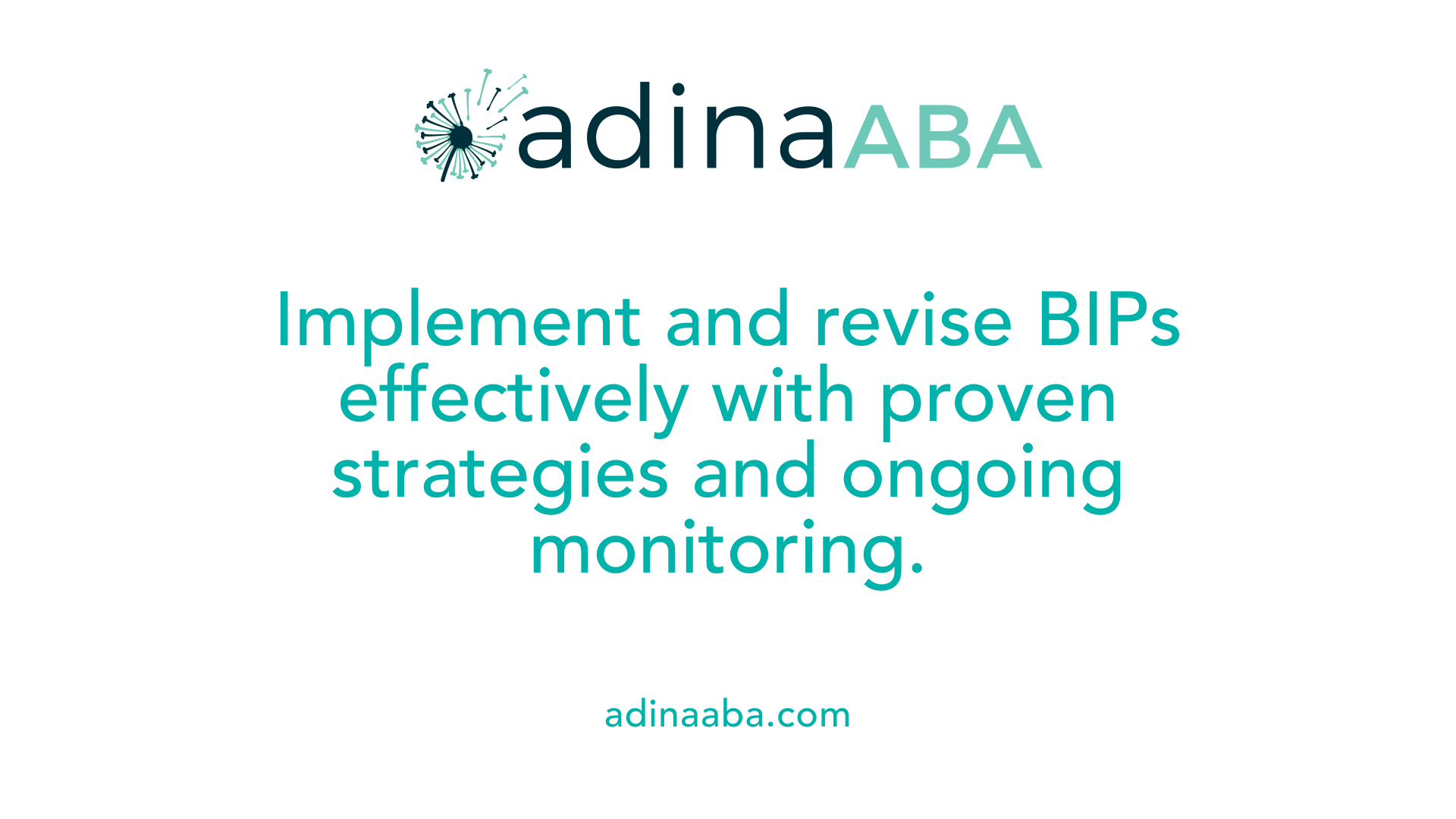When to update your behavior intervention plan

Understanding the Importance of Regular BIP Updates
A Behavior Intervention Plan (BIP) is an essential tool designed to help children with problematic behaviors succeed academically and socially. To maximize its effectiveness, a BIP must be dynamic—subject to regular review and revision as necessary. This article explores when and how to update a BIP, emphasizing the importance of ongoing assessment, stakeholder engagement, and adherence to legal requirements.
Identifying When a BIP is Necessary to Implement
When is it appropriate to implement a Behavior Intervention Plan (BIP)?
A BIP should be put into action when a student’s behaviors significantly interfere with their own learning or disrupt the classroom environment. Such behaviors might include frequent outbursts, defiance, or other disruptive actions that hinder educational progress.
In many cases, existing supports like a 504 plan or an Individualized Education Program (IEP) are not enough to manage these behaviors effectively. When accommodations do not reduce or eliminate troubling behaviors, a BIP is often the next step.
A crucial component of forming a BIP is the Functional Behavioral Assessment (FBA). This assessment looks into why a behavior occurs by examining triggers, environmental factors, and the purpose the behavior serves for the student.
The results from an FBA help identify specific functions behind behaviors, such as seeking attention, escaping difficult tasks, gaining sensory input, or obtaining desired items or activities.
Based on these findings, a BIP is developed to target behaviors with tailored strategies. These include positive reinforcement, environmental modifications, teaching replacement skills, and proactive classroom adjustments.
The plan should clearly describe the problematic behaviors, the reasons they happen, and the strategies to replace them with appropriate alternatives. Importantly, a BIP is most effective when created through collaboration involving educators, parents, and specialists, ensuring everyone understands and supports the plan.
Furthermore, a BIP isn’t a one-time intervention. It requires ongoing review and adjustments based on data gathered through progress monitoring. This continuous process helps ensure the strategies remain suitable, effective, and responsive to the child's changing needs.
Ultimately, implementing a BIP supports children in learning positive behaviors, enhances their engagement in school activities, and contributes to a safer, more inclusive learning environment. Regular assessment and modification of the BIP align the intervention with the child's development, maximizing the chances of success.
The Critical Role of Functional Behavioral Assessments (FBAs)

Purpose of FBA in developing BIP
A Functional Behavioral Assessment (FBA) is an essential step in creating an effective Behavioral Intervention Plan (BIP). Its primary purpose is to identify the reasons or functions behind a child's challenging behaviors. By understanding why a behavior occurs—such as seeking attention, escaping from tasks, or gaining access to items—educators and specialists can design tailored strategies that target the root causes. This ensures the interventions are relevant and more likely to succeed.
Conducting FBA by trained professionals
FBAs are conducted by qualified specialists such as psychologists, social workers, or behavior analysts. These professionals are trained to observe, record, and analyze behaviors systematically. The assessment process often includes direct observations in the child's natural environment, detailed interviews with teachers and caregivers, and review of relevant records. Their expertise helps ensure that the functional analysis accurately identifies the behavior's purpose, which is crucial for developing effective interventions.
Information gathered during FBA
During an FBA, various types of information are collected to create a comprehensive picture of the child's behavior. This includes identifying the specific behavior patterns, the context in which the behavior occurs, triggers or antecedent conditions, and the consequences maintaining the behavior. The assessment also considers environmental factors, the time and setting of incidents, and any patterns over time. Gathering detailed data allows the team to hypothesize the function of the behavior and develop strategies that address those underlying needs.
Understanding the importance of the FBA and ensuring it is properly conducted helps create a targeted BIP that promotes positive change and supports the child's learning and social success.
How often should a Behavior Intervention Plan (BIP) be reviewed and updated?
The BIP should be reviewed at least annually during an IEP meeting and whenever there is a significant change in the child's progress or behavior. Additionally, parents, teachers, or support staff can request a review if they notice that strategies are not effective. Regular updates ensure that the interventions remain relevant and responsive to the child's evolving needs, thereby increasing the likelihood of positive behavioral outcomes.
Recognizing Indicators for BIP Revisions
 A Behavior Intervention Plan (BIP) should be a dynamic tool that adapts to a student's evolving needs and circumstances. Recognizing when it’s time to revise or update the plan is essential for ensuring continued progress and effectiveness.
A Behavior Intervention Plan (BIP) should be a dynamic tool that adapts to a student's evolving needs and circumstances. Recognizing when it’s time to revise or update the plan is essential for ensuring continued progress and effectiveness.
One clear indicator is a lack of progress despite the implementation of current strategies. If a student is not meeting behavioral goals or the behaviors are persistent over time, it suggests the interventions may not be adequately addressing the root causes or might need refinement.
Data collected during the intervention process also provides crucial insights. If the information shows that the strategies are ineffective at reducing problematic behaviors, or worse, are causing negative side effects such as increased frustration or disengagement, the BIP needs re-evaluation.
Changes in student needs or circumstances are another vital factor. As children grow and develop, their behaviors and motivations may shift, necessitating updates to the BIP to keep interventions relevant and supportive.
Stakeholder feedback is invaluable in this process. Input from teachers, parents, or other caregivers who observe the student daily can highlight aspects of the plan that are not working or require adjustments.
Regular data analysis and ongoing monitoring—key components of an effective BIP process, as promoted by initiatives like the statewide COMPASS project—help identify these indicators early. When the data reveal persistent issues or new challenges, it signals that a revision is needed to better support the student.
In summary, signs that a BIP needs updating include stagnating progress, ineffective or harmful interventions, changing student needs, and stakeholder concerns. Regular review programs ensure that the plan remains aligned with the child's current requirements, facilitating meaningful behavioral improvements and success in the educational environment.
Legal and Procedural Requirements for Updating BIPs
When is it appropriate to implement a Behavior Intervention Plan (BIP)?
A BIP is developed when a student displays behaviors that significantly interfere with their learning or the learning environment. This is especially relevant when existing accommodations, such as a 504 plan or an Individualized Education Program (IEP), are not sufficient to manage these behaviors. The process begins with a functional behavior assessment (FBA), which uncovers the reasons or functions behind the problematic behaviors. Based on this assessment, the IEP team creates a tailored plan that includes strategies like reinforcement, classroom modifications, and teaching replacement skills.
The BIP aims to promote positive behaviors through proactive supports and interventions. It involves collaboration among educators, parents, and support staff, ensuring the strategies are consistent across settings. The goal is to address the specific behaviors that hinder learning and to help the student develop appropriate skills, thus improving their educational experience.
What are signs that indicate a Behavior Intervention Plan (BIP) needs to be revised or updated?
A BIP should be reviewed regularly to ensure its continued effectiveness. Signs that a revision is necessary include a lack of progress toward behavioral goals despite proper implementation. If data shows that problem behaviors persist or worsen, or if the interventions are producing unintended negative effects, updating the plan becomes essential.
Changes in the student’s circumstances, developmental stage, or related needs may also call for revisions. For instance, if new triggers emerge or if existing strategies are no longer appropriate, adjustments should be made to better support the student.
Feedback from teachers, parents, and other stakeholders is vital. If these parties observe that the BIP is ineffective or outdated, it’s a signal for the team to revisit and modify the plan. Regular data collection and analysis—key components in programs like COMPASS—help administrators determine when the BIP needs updating. These steps ensure that the intervention remains relevant, effective, and aligned with federal regulations.
Monitoring and Evaluating BIP Effectiveness over Time
What methods of data collection are used and how frequently?
Effective monitoring of a Behavior Intervention Plan (BIP) relies heavily on systematic data collection. This can include frequency counts, duration recordings, and intensity ratings of specific behaviors. Data should be collected regularly—often daily or weekly—depending on the intensity of the behaviors and the goals set in the BIP.
Frequency counts track how often a problematic behavior occurs within a given time period, providing clear quantitative data on progress or setbacks. Duration data measure how long the behavior lasts, which is useful for behaviors that may occur repeatedly or last for extended periods.
Types of data collection also include anecdotal records, checklists, and electronic data tools, which help ensure consistency and accuracy across different staff members.
What is the role of progress monitoring?
Progress monitoring is a continuous process that involves reviewing collected data to assess how well the interventions are working. It helps identify whether a child’s behaviors are improving, staying the same, or worsening over time.
Ongoing progress data informs decisions about whether to continue, modify, or replace specific strategies within the BIP. If goals are not being met despite consistent application of strategies, the data signals a need for reassessment.
Monitoring helps maintain a focus on measurable outcomes, promotes accountability among staff, and ensures that the intervention remains aligned with the student’s current needs.
How does proper staff training impact BIP implementation?
Staff training plays a crucial role in the success of a BIP. Properly trained staff are more likely to implement strategies with fidelity, which means they follow the plan as intended. This consistency is essential for accurate data collection and achieving desired behavioral outcomes.
Training should cover understanding the functions of behaviors, use of reinforcement techniques, crisis procedures, and data collection methods. When staff are confident and competent, it not only enhances the effectiveness of interventions but also increases staff buy-in and the perceived acceptability of the plan.
Improper or inconsistent implementation due to lack of training can lead to misleading data and hinder progress, making it critical to invest in ongoing professional development.
How should strategies be adjusted based on data?
Adjustments to strategies should be guided by data analysis. When data indicates minimal or no progress, or if problem behaviors persist or increase, the intervention plan needs revision.
Such adjustments may include changing antecedent conditions, reinforcing alternative behaviors more effectively, or modifying the environment. Sometimes, new triggers may be identified, requiring an update to the intervention.
Flexibility in modifying strategies ensures that the BIP remains relevant and effective. Regular review sessions with the IEP team allow for collaborative decision-making based on recent data.
Ultimately, data-driven modifications aim to enhance positive behavior change, support the student’s development, and ensure the BIP’s overall success.
Best Practices for Successful BIP Implementation and Revision

How often should a Behavior Intervention Plan (BIP) be reviewed and updated?
The BIP should be reviewed at least annually during an IEP meeting, or more frequently if there are concerns about its effectiveness. Revisions are necessary whenever the child's behavior does not improve, or if new challenges arise, ensuring the plan remains relevant and effective.
Stakeholder collaboration and buy-in
Implementing a BIP successfully requires active participation from all involved parties. Teachers, parents, support staff, and the student should collaborate to develop and review the plan regularly. Their buy-in is essential for consistent application of strategies across settings. Clear communication fosters understanding and commitment, which increase the likelihood of positive outcomes.
Staff training and consistency
All staff working with the child must be trained on the specifics of the BIP to ensure consistency. Proper training covers the intervention strategies, reinforcement techniques, and data collection procedures. Consistent implementation across environments helps reinforce positive behaviors and reduces confusion or mixed messages that might impede progress.
Data-driven decision making
Ongoing data collection is vital. Regularly tracking behavior through measures like frequency, duration, or intensity guides the evaluation of the BIP's effectiveness. Data analysis informs whether strategies should be maintained, modified, or replaced, ensuring interventions are tailored to the child's evolving needs.
Reinforcement and motivation strategies
Positive reinforcement is a cornerstone of effective BIPs. Rewarding desired behaviors encourages their recurrence and helps build new skills. Strategies should be personalized to motivate the child, using praise, tokens, or preferred activities. Ensuring the reinforcements are immediate and meaningful maximizes their impact.
| Aspect | Recommendations | Additional Notes |
|---|---|---|
| Review Frequency | At least once a year or when needed | Adjust based on behavior progress or new challenges |
| Stakeholder Engagement | Regular meetings with parents, teachers, and support staff | Foster trust and shared responsibility |
| Staff Training | Comprehensive, ongoing training sessions | Cover intervention strategies, data collection, and reinforcement |
| Data Collection & Analysis | Use consistent methods for tracking behaviors | Guide modifications of the BIP |
| Reinforcement Strategies | Personalize rewards and provide immediate feedback | Reinforce positive behaviors to sustain change |
By aligning these practices with the child’s needs and maintaining open communication among all stakeholders, schools can create a supportive environment that effectively reduces problematic behaviors and promotes positive development.
Conclusion and Summary of Key Points
Regular review and updates of a Behavior Intervention Plan (BIP) are essential to ensure its ongoing effectiveness. A well-maintained BIP adapts to the changing needs of the student, addressing new challenges and reinforcing positive behaviors. Signs that indicate a BIP needs revision include lack of progress despite consistent implementation, data showing that problem behaviors are not decreasing or are worsening, and reports from teachers or parents that the current strategies are ineffective or causing unintended negative effects.
Legally, schools are required to review and revise BIPs periodically, especially when a student's behavior impedes learning or if the plan is not producing desired outcomes. According to IDEA regulations, a BIP should be reviewed at least annually, but more frequent updates are encouraged if data or circumstances suggest they are necessary.
Best practices also recommend ongoing monitoring and data collection to evaluate the plan's success. This continuous oversight allows educators and caregivers to identify early signs that the plan may need adjustments, such as when a student no longer benefits from certain interventions or when new behaviors emerge. Using data and stakeholder feedback helps keep the BIP aligned with the student’s current needs.
In summary:
- Consistent review and adjustment of the BIP are vital for supporting student progress.
- Indicators for revision include stagnation or deterioration of behavior, and stakeholder concerns.
- Legal mandates, like IDEA, enforce periodical review, with provisions for more frequent updates.
- Ongoing data collection and analysis serve as the foundation for informed decision-making.
By adhering to these principles, educational teams can develop dynamic, personalized strategies that foster positive behavioral changes, paving the way for academic success and social growth.
Final thoughts on BIP updates
In conclusion, a Behavior Intervention Plan should never be static. Regular reviews—at least annually—are essential to ensure strategies remain effective and responsive to the student's changing needs. Stakeholder collaboration, continuous monitoring, and timely revisions based on data are critical to fostering positive behavioral growth. Adhering to legal requirements and best practices not only supports compliance but also maximizes the plan’s impact in promoting student success.
References
- What Is a Behavior Intervention Plan? - Child Mind Institute
- [PDF] Behavior Intervention Plans (BIPs) Fact Sheet
- How to Address a Student's Problem Behavior: Functional ...
- 5: Developing the Behavior Intervention Plan
- Behavior Intervention Plans and Schools | Navigate Life Texas
- [PDF] BEHAVIOR INTERVENTION PLAN
- What Is a Behavior Intervention Plan? [PDF Template]
- What is a behavior intervention plan? - Understood.org
More Resources
Expert Clinicians
Get started today ->






